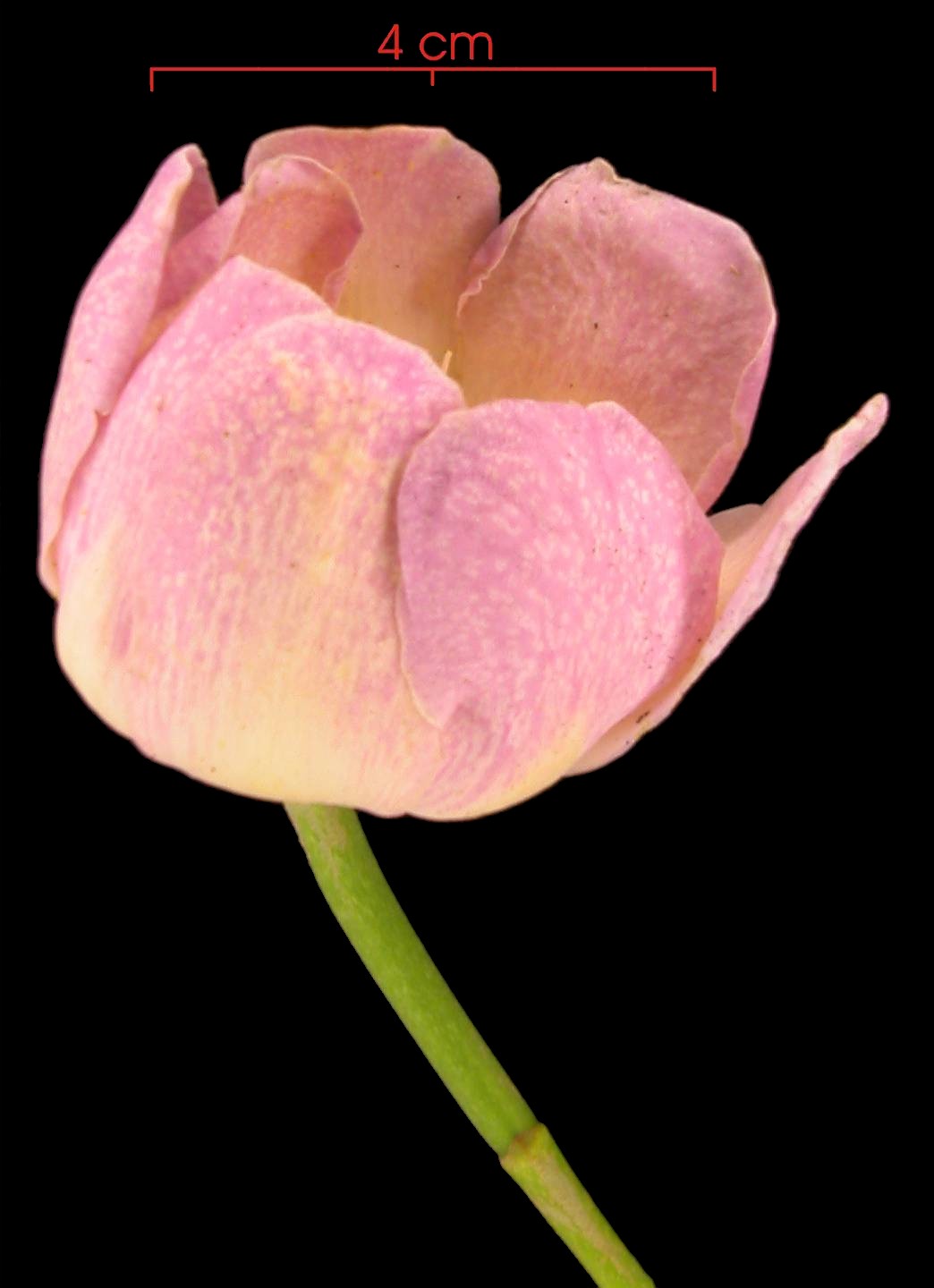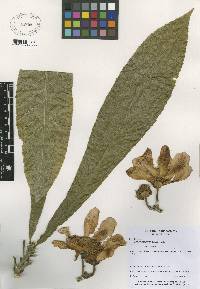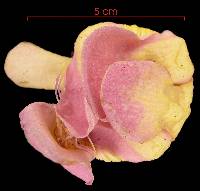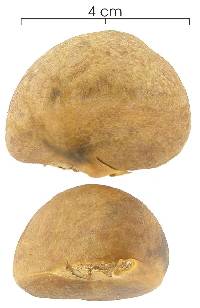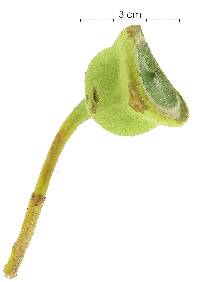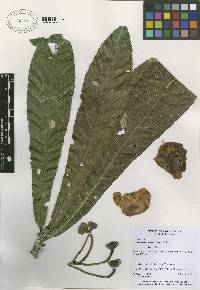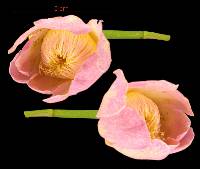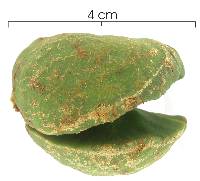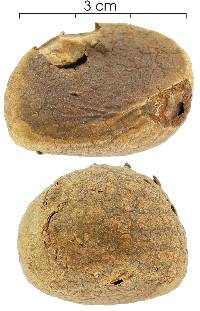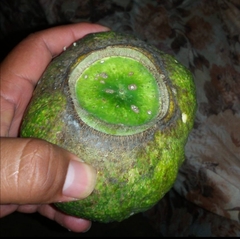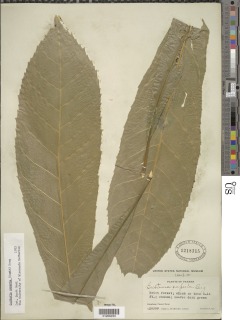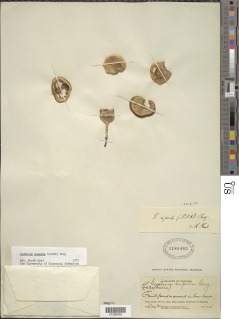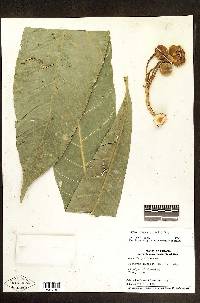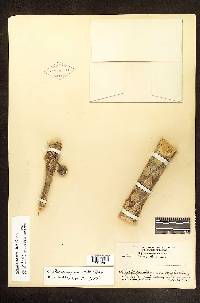

|
|
|
|
Family: Lecythidaceae
membrillo, more...tupu
|
Description: A medium-sized tree with a straight trunk that is often unbranched, with just one cluster of leaves at the top of the trunk (like a palm). In big trees, though, there are a few large branches, each with a cluster of leaves at the end. Leaves are very large -- no other tree in the area other than palms -- has larger leaves. They are toothed, long, narrow at the base, and broad at the apex. Reproduction: Flowers are large and purple, with many stamen arranged in a ring, few in number. From March to June, when they are mature, a few flowers can easily be found on ground beneath adult trees. Fruits are round, green, hard, larger and heavier than a baseball. Inside are a few large seeds. The fruits often remain on the ground for weeks, rotting and collecting mold. Agoutis eat the seeds, but they also bury some for later use and thus serve as dispersal agents. Distribution: An abundant tree in secondary forests in the central part of the isthmus, less common at Sherman, and not seen in forests near Panama City or at the wettest Caribbean sites. At Plantation Rd near summit, around Gamboa, along Pipeline Rd out to the Rio Limbo, and at Barro Colorado this species is the dominate secondary forest tree. In some sites, Gustavia makes up 50% of the canopy. Anywhere in the central part of the isthmus it is a good indicator of forest that has been regenerating for 60-100 years. It is much less common in old-growth, and does not typically form the earliest regeneration. It is also fairly common in abandoned pastures, apparently because agoutis take the seeds out into the fields, and because the very large seeds allow seedlings to germinate in harsh pasture conditions. Similar Species: The long leaves in a single cluster at the apex of a large branch or trunk are unmistakable. In the center part of the isthmus, there is just one other species that is similar, LK cespma Cespedezia macrophylla. LK2 The two species are unrelated, and have completely different flowers. But without flowers they are easily confused, and both are common along Pipeline Rd. Indeed, a prominent publication in Science years ago was based on mis-identification of Cespedesia and Gustavia at Pipeline Rd. With a fallen leaf in hand, look closely at the leaf underside -- the smallest veins of Cespedesia are prominent and parallel, whereas in Gustavia they are inconspicuous and widely spaced. On the trees, Gustavia leaves tend to droop downward much more than Cespedesia leaves, some of which point upward, and new leaves of Cespedesia are conspicuously red, unlike Gustavia. There are other relatives of G. superba in the area -- LK gustfo G. fosteri, LK2 LK gustdu G. dubia, LK2 and LK griaca Grias cauliflora. Descripción: Árbol de 5 a 20 m de alto. Tronco ramificado a baja altura. Corteza exterior negra y lenticelada. Ramitas terminales robustas y con cicatrices de las hojas que han caído. Hojas simples y alternas, grandes, alcanzando de 50-100 x 7-30 cm, oblanceoladas, con ápice acuminado, bordes dentados y base decurrente. Las hojas se encuentran agrupadas en los extremos apicales de las ramas. Cuando las hojas se descomponen en el suelo del bosque despiden un olor fétido. Pecíolo de 2-10 cm de largo, pulvinado en la base. Inflorescencias caulinares, saliendo de las partes defoliadas de las ramas. Flores rosadas y con los estambres agrupados en el centro. Frutos en pixidios globosos e indehiscentes, de 7-10 cm de diámetro, verdes y con una estructura en forma de anillo en la punta, tornándose amarillos al madurar. Datos Ecológicos: La especie crece a bajas o medianas elevaciones, en bosques húmedos o muy húmedos. En Panamá se encuentra en las provincias de Chiriquí, Coclé, Colón, Darién, Herrera, Panamá, Veraguas y la comarca de Guna Yala. Común y fácil de observar en bosques secundarios del Canal de Panamá. Florece y fructifica de marzo a septiembre. Las flores son visitadas por moscas, hormigas, abejas y murciélagos. Los frutos forman parte de la dieta de monos, ñeques, conejos, ardillas y saínos. En la isla de Barro Colorado los frutos maduros que caen al suelo del bosque son atacados por las larvas de un Lepidóptero de la familia Sesiidae. Especies Parecidas: A menudo se confunde con LK cespma Cespedesia spathulata LK2 , pero C. spathulata tiene estípulas grandes y de color marrón castaño, las flores son amarillas y los frutos son cápsulas pequeñas que contienen muchas semillas aladas. Los juveniles de G. superba se pueden confundir con LK clavco Clavija costaricana LK2 , pero C. costaricana es un arbusto que presenta ramificación monopódica. LK griaca Grias cauliflora LK2 tiene hojas muy parecidas, pero en G. culiflora las hojas presentan los bordes enteros y las flores son blancas. LK gustfo Gustavia fosteri LK2 también tiene hojas muy parecidas a G. superba, pero en G. fosteri las flores salen de una inflorescencia terminal o subterminal. Usos: Los indígenas de la provincia del Darién en Panamá comen los frutos crudos, en sopa o cocidos con arroz. Con las hojas se fabrica un té medicinal. Los árboles de esta especie tienen mucho potencial como planta melífera en fincas dedicadas a la apicultura. Trees, mostly 6-10 (15) m tall; trunks usually less than 20 cm dbh, branching infrequently; wood moderately hard. Leaves alternate, crowded at ends of stout branches; petioles very short or to 11 cm long on juveniles; blades elliptic-oblanceolate, abruptly acuminate, narrowly cuneate and more or less decurrent onto petiole, mostly to 1 m or more long and 25 cm wide, glabrous, coarsely toothed. Corymb short, beneath leaves; pedicels stout, to ca 8 cm long, minutely puberulent; flowers mostly to 12 cm diam; hypanthium turbinate, to 2.5 cm wide; calyx obscure; petals 6-12, unequal, +/- spatulate, oblong, to 7 cm long and 3.5 cm wide, white to cream or spotted with lavender, especially on outside; stamens many, ca 4 cm long, fused one-third their length into a yellowish ring; filaments fleshy, arched inward, often tinged with lavender above, constricted just below anther; stigma short-conical. Pyxidia depressed-globose, 7-10 cm broad, to ca 8 cm long, indehiscent, baccate, with a prominent raised ring at apex, green or pale yellow to orange at maturity with irregular brown lenticels and minute longitudinal ribs, often with a foul odor at maturity; seeds few, fleshy, irregularly shaped, to ca 6 cm long. Croat 5095, 8812. The species is easily confused with G. grandibracteata Croat & Mori, which is to be expected on the island. The key for this family gives the distinguishing characteristics. Woodson and Schery in the Flora of Panama (1958a) reported the range of G. superba to be as far south as Ecuador; they were confusing the species with G. angustifolia Benth., which occurs there. |
|
|
|

